What makes the Ford Edge not just another crossover SUV?
Two things.
One, its size. It falls in between mid-sized and super-sized. Two unusually generous rows of seats for a vehicle of its size. It has nearly as much backseat legroom as some of its larger on the outside rivals have up front – and more than they do in their second rows.
A variety of horsepower.
You can get it with a 315 hp twin-turbo V6. Or a V6 without turbos – and with 280 hp.
Or a turbo four with 245 hp.
Most of its price-equivalent rivals are appliances, built to carry people and cargo but not light your fire. To find something that does, you pretty much have to step up to a higher-priced luxury-badged crossover – something in the Acura/BMW/Lexus line.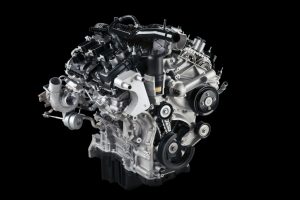
And that, of course, will cost you.
A Lexus RX350, for instance, starts at $43,220 – and its V6 (no turbos) makes less power (295 hp) than the Ford’s top-gun V6. And if you want all-wheel-drive, it costs more: $44,620 to start vs. $40,675 for the twin-turbo’d Ford with AWD.
An Edge with the mid-range 280 hp V6 – or the standard turbo four – is an even sweeter deal.
No extra charge for the extra roomy backseats.
The Edge is a mid-sized, two-row crossover SUV designed it to appeal to people who don’t need three rows (that’s where Explorer comes in) but who want business class room in two rows – as well as something going on under the hood.
It’s available in base SE, mid-trim SEL, Titanium and high-performance Sport trims.
All trims – including the base SE with the four-cylinder engine – are available with FWD (standard) or AWD (optional).
Prices start at $29,220 for a FWD SE trim.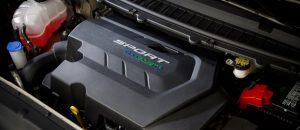
A top-of-the-line Edge Sport – with the twin-turbo 2.7 V6 and AWD – starts at $40,675.
In between are SEL and luxury-themed Titanium trims, each of which can be ordered with your choice of the turbo four or the no-turbos V6 under the hood.
The ’18 Edge carries over unchanged.
WHAT’S GOOD
More engine choices – and power – than rivals.
More backseat room than rivals.
AWD is available with the four cylinder engine; no up-selling you to the V6 to get it.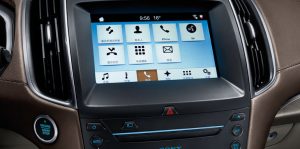
Ford’s updated Sync3 infotainment interface is intuitive and easy to use while the vehicle is in motion (many others are awkward to use unless the vehicle isn’t moving).
WHAT’S NOT SO GOOD
Both of the Edge’s turbo’d engines – including the standard 2.0 engine – need premium fuel to deliver on their horsepower (and fuel economy) numbers.
The Edge’s standard engine is 2.0 liter, 245 hp four cylinder; it’s paired up with a six-speed automatic and your choice of FWD or (optionally) all-wheel-drive.
The previous Edge also offered a turbo four – but not with AWD. If you wanted AWD, you had to move up to either of the two available V6s.
And, of course, pay up.
On paper, the current 2.0 turbo four seems to be about the same, power-wise, as the previous generation Edge’s 2.0 four. They’re the same size, both turbo’d; the current iteration producing only 5 more hp on paper than the old 2.0 engine did.
But while it’s superficially similar to the old 2.0 engine, the current Edge’s 2.0 liter engine is a heavily revised engine, effectively an all-new engine. It features a twin-scroll turbo and an exhaust manifold cast integrally as part of the cylinder head. These design changes result in almost-immediate boost and so very little turbo lag.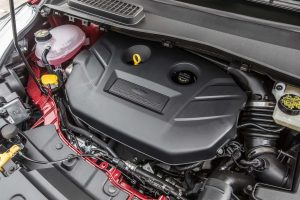
The 2.0 engine also features revised camshaft timing, higher compression (9.7:1 vs. 9.3:1 before) and direct (rather than port fuel) injection. The block is a lighter casting which, along with other weight-saving measures, is what made it possible for Ford to offer the four and AWD together. In the old Edge, the four was on the edge of being underpowered in the FWD version. The added weight (and load) of AWD was a touch too much – which is why Ford only offered AWD with the larger/stronger V6.
Also: The four cylinder Edge can pull.
Even with its standard engine, you can hook up a 3,500 lb. trailer to the thing. The Nissan Murano – which comes standard with a mulch larger (3.5 liter) but not much more powerful (260 hp) V6 can only pull 1,500 lbs. Its weak tow rating may be a function of the fact that its V6 is mated to a continuously variable (CVT) automatic and these boxes – while fuel-efficient – are not built to pull.
The Ford offers two other engines, too – vs. the Murano’s just-the-one.
For the traditionalist – the buyer who is maybe a little leery of turbo’d engines but wants more power – there is the non-turbo 3.5 liter V6. It’s also offered with – and without – AWD and makes 280 hp (20 more hp than the Nissan’s V6). It makes almost as much power as the standard V6 in the $10k-plus-more-expensive Lexus RX350 F-Sport (295 hp). 
The top Edge engine is the “Ecoboost” 2.7 liter twin-turbo V6. It makes more power than the RX 350’s V6s.
315 hp and 350 ft.-lbs. of torque – both numbers in the V8 ballpark.
Ford fans will recognize this powerhouse powerplant. It made its debut in the aluminum-bodied F-150 pick-up truck. In the Edge, it produces a bit less power – but 315 is still a step up from the 305 hp produced by the previous Edge’s optional 3.7 liter V6 and absolutely blows the Murano’s 260 hp V6 into the weeds.
The 2.7 engine features a graphite-impregnated iron-alloy block for high strength and light weight. Plus a pair of twin-scroll turbos. It is one of the strongest engines currently available on a power-per-liter basis and otherwise.
The Sport is capable of getting to 60 in about 6.4 seconds – quicker than the Murano and right there with the Lexus RX350 F Sport.
Mileage with this engine is 17 city, 24 highway.
Premium fuel is recommended for both the Edge’s turbo engines but the no-turbos V6 is set up for regular.
Your test drive will take longer.
So many crossovers offer just one – and sometimes two engines.
The standard engine usually being on the edge of underpowered.
The Edge’s three engines – none of them weak – give you a lot to think about.
The standard 2.0 four is ideal for suburbia because of its strong low-end torque – 270 ft. lbs. – which is more torque (and sooner) than the next-up 3.5 liter V6 . It also delivers strong mid-range power that pulls the Edge smartly from light to light. 
The no-turbos 3.5 liter V6, on the other hand, has more horsepower on top and pulls harder at highway speeds. It also comes without any angst about possible down-the-road turbocharger trouble.
The Sport with the twin-turbo 2.7 V6 is its own animal – a different species, really. If Ford wicked up the boost a bit, this one could be a blue oval version of the Mercedes AMG 45 GLA. As it comes, you get the best of both worlds: The right-now torque of the turbocharged four (and more torque) as well as the high-up horsepower of the 3.5 liter V6 (and more of that, too.)
The Sport also gets different suspension tuning, including monotube shocks with larger diameter pistons unique to this trim, along with stiffer roll bars, coil springs and adaptive steering that changes effort based on driving conditions.
A 20 inch wheel/tire package is standard as well.
One thing it has that I personally wish it didn’t come standard with is Active Noise Cancellation technology. This generates sound waves that cancel out – as far as your ears are concerned – the sounds made by the engine.
There are still a few freaks like me who want to hear the engine – especially when it’s a sweet sounding twin-turbo engine.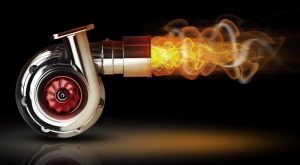
But Ford – and most other car companies now offering turbocharged engines – do their best to cover up the fact that they are turbocharged. They aren’t shy about advertising the fact that there’s a turbo (or two) under the hood. But you’ll listen in vain for any whistle or wastegate pop.
No turbo drop-kick of boost, either. The power curve is steady rather than steep.
Which is what they were after, of course.
These smaller turbo’d engines are meant to replicate the power delivery characteristics of larger-displacement engines, while using a bit less gas.
Which they do – if you don’t make full use of the turbos.
Which is right up there with just having a spoonful of your favorite ice cream and then putting the rest back in the fridge.
Another area where the Edge has an edge is the relationship between its overall size and the space inside.
It is 188.1 inches long, which is longer than a compact-sized crossover like the Chevy Equinox (183.1 inches) but not nearly as long as a full-sized bus like the Chevy Traverse (204.3 inches).
And rather than a tight second row – to make space for an even tighter third row – the Edge very deliberately has two rows, both of them extremely spacious.
Up front, 42.6 inches of legroom. In the second row, 40.6 inches. 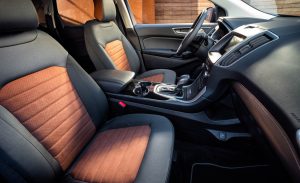
The much larger Chevy Traverse has a third row – but it has less room in its two other rows (41 inches up front and 39 in the second) and the third row is really a kids-row-only. Adults can sit back there, but not comfortably.
Another thing about the Edge: It is wide. The spaciousness to the sides especially is striking. The driver doesn’t sit shoulder-to-shoulder with the front seat passenger. You each occupy your own opulent space.
Ditto in back.
Notice the concavity of the door panels. They were scalloped out to make more room for your elbows. Just as the backs of the front seats were similarly scooped out to make even more room for your knees. A 6ft 3 man can sit in the backseat of the Edge with the driver’s seat pushed back to accommodate a 6ft. 3 man and still have 8 inches of air space between his knees and the backs of the front seats. 
Cargo room is split-the-difference: There’s 39.2 cubic feet behind the second row up and 73.4 with the second row folded flat.
The Nissan Murano still has slightly more cargo room: 39.6 cubes behind its second row. But it has nearly two inches less legroom (38.7 inches) for second-row passengers. The goliath-sized Chevy Traverse has 98.5 cubic feet of total capacity with its first and second rows down – but only 23 cubic feet behind the third row, which is significantly less than the Ford has with its seats in place.
The smaller Chevy Equinox is admirably space efficient – with 29.9 cubic feet of cargo capacity behind its second row and a total capacity of 63.5 cubic feet. It is also impressively roomy in both rows: 40.9 cubic inches of legroom up front and 39.7 in the second row. But it’s not as wide to the sides – and it does not offer a comparably powerful engine lineup.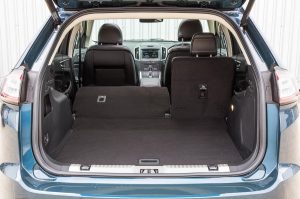
Cosmetic details: The current Edge is less blocky than the first-gen model; the grille has outward tapering sideways “Vs” instead of the bar-grille used before. Manual pull-up-and-down interior door locks have been replaced by entirely electronic ones.
There is a front seat passenger knee air bag; driver’s side knee air bags are not new – this is – as well as air bags built into the rear seat belts. The Edge’s rear liftgate can be opened hands-free by swiping your foot underneath the bumper.
Redesigned seat heaters and coolers are available, as are MyKey concierge/teenager controls you can use to limit the vehicle’s top speed and other functions.
This Ford that can park itself perpendicularly (into and out of spots in a row, as in a shopping mall) as well as parallel park itself curbside. There is a camera built into the grille – with its own washer jet, so its view is never impaired by road grime.
Your only job is to give it a little gas.
The car will adjust and steer itself into the spot.
The Art of the Parallel Park is rapidly becoming rare – and irrelevant. People aren’t taught – and the skill is no longer expected. This is the future, unfortunately.

The Edge also has a semi-automatic steering system that applies corrective inputs when the driver fails to keep the car in its lane. People (a lot of them) seem to want such stuff and I concede it is technologically impressive stuff.
But it makes my teeth hurt.
THE BOTTOM LINE
The Edge is aptly named.
More engine – and more room – without more size.
. . .
Got a question about cars – or anything else? Click on the “ask Eric” link and send ’em in!
If you like what you’ve found here, please consider supporting EPautos.
We depend on you to keep the wheels turning!
Our donate button is here.
If you prefer not to use PayPal, our mailing address is:
EPautos
721 Hummingbird Lane SE
Copper Hill, VA 24079
PS: EPautos stickers are free to those who send in $20 or more to support the site. Also, the eBook – free! – is available. Click here. Just enter you email in the box on the top of the main page and we’ll email you a copy instantly!


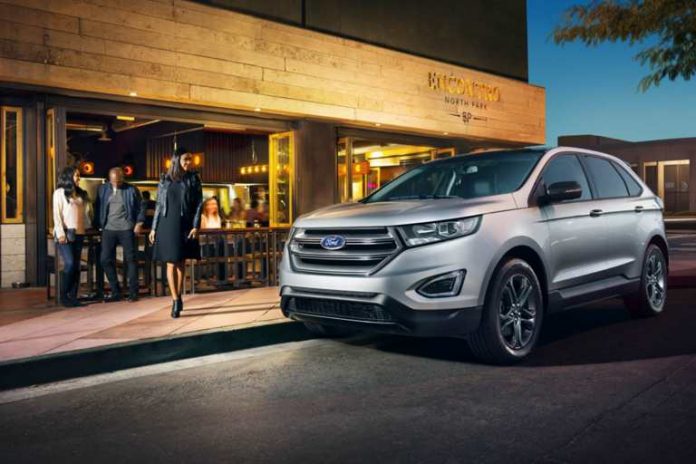

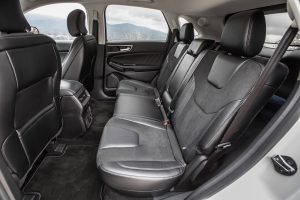



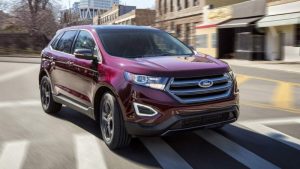











I haven’t ridden in the new version, but the previous Edge truly did have a WIDE interior. You had absolutely no issue with shoulder width. It was actually a little disconcerting, and you got the impression that the vehicle was as wide as it was long. I’m hoping that the interior of the new one is a step up – the last one had door panels that were on the downmarket side – lots of hard uncomfortable plastic, even where you’d naturally rest your arm.
Hi Chip,
As a big guy, I love the spacious feel. The main defect, in my opinion, is the instrument cluster – which is perfectly functional but also perfectly identical to the ones used in much lesser Fords. Not bad Fords, but lower priced ones. I think the Edge deserves a nicer, more upmarket gauge cluster…